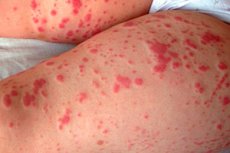Medical expert of the article
New publications
Meningitis rash
Last reviewed: 29.06.2025

All iLive content is medically reviewed or fact checked to ensure as much factual accuracy as possible.
We have strict sourcing guidelines and only link to reputable media sites, academic research institutions and, whenever possible, medically peer reviewed studies. Note that the numbers in parentheses ([1], [2], etc.) are clickable links to these studies.
If you feel that any of our content is inaccurate, out-of-date, or otherwise questionable, please select it and press Ctrl + Enter.

The leading cause of inflammation of the soft membranes of the brain of bacterial etiology is the bacterium Neisseria meningitides, whose invasive effects are manifested by a number of symptoms, one of which is meningitis rash.
That is, the presence of this skin symptom is seen in meningococcal meningitis and fulminant (rapidly progressing) meningococcemia, which often occur together.
Epidemiology
According to clinical observations, petechial rash in meningitis in adults and children occurs in 50-75% of cases.
The fact that skin manifestations of meningococcal infection do not occur in everyone, experts explain the presence of a significant number of strains of this bacterium, some of which have a lower level of virulence.
Causes of the meningitis rash
Gram-negative aerobic bacteria - meningococci neisseria meningitidis - belong to obligate human pathogens: in almost 10% of healthy people they colonize the nasopharyngeal mucosa, and at the age of 15-24 years almost one third of people with good immunity are its asymptomatic carriers.
Causes of skin symptom in meningococcal meningitis are due to the infection entering the bloodstream and cerebrospinal fluid (liquor), where they multiply.
The rash in meningitis is actually not a rash, but pinpoint capillary hemorrhages localized in the skin or under the skin - purpura or petechiae. And this is the most common skin sign of meningococcal infection. [1]
Pathogenesis
The basis of virulence of N. Meningitidis is a transformable genome; the ability to evade the body's natural defense mechanisms by suppressing phagocytosis with the peptidoglycan of its polysaccharide capsules; aggressive colonization of the mucosal epithelium and its invasion with the help of its villi (flagella) and membrane adhesin proteins; expression of surface proteins-antigens and lipo-oligosaccharide (LOS) endotoxin, which is located in the outer membrane of the bacterial cell.
The pathogenesis of hemorrhagic skin lesions in meningitis and meningococcemia (meningococcemia) is due to the fact that N. Meningitidis, entering the bloodstream, leads to bacteremia, colonizes the endothelium of blood vessels and causes the development of disseminated intravascular coagulation (DIC) syndrome blood.
This is the result of the bacterial capsular protein α-actinin-4 attaching to endothelial cells by acting on their receptors (CD147 and β2AR), pathologic alteration of the membranes of these cells, and disruption of intercellular junctions. In addition, the walls of blood vessels are affected by bacterial endotoxins, which are released into the bloodstream when they are destroyed.
As a result, thrombohemorrhagic blood coagulation and local inflammatory reactions develop.
Symptoms of the meningitis rash
Symptoms of thrombohemorrhagic coagulation caused by meningococci are petechiae or pitting hemorrhagic rash, which are small red or purple spots that do not disappear when pressure is applied to the skin.
What does meningitis rash look like? In children and adults, meningitis rash on the skin - on the trunk, limbs, and other parts of the body - may look like tiny red, pink, brown, or purple dots and bruise-like purple (purple) spots. Pale or blotchy patches on the skin may appear, as well as a diffuse erythematous maculopapular (patchy nodular) rash. Petechial red spots usually do not cause symptoms such as pain or itching.
But it should be borne in mind that in meningitis the rash may be absent or very scanty and inconspicuous, but may spread to more extensive areas of the skin. [2]
Complications and consequences
The main complications and consequences are related to the development of foci of skin necrosis due to the fact that capillary hemorrhages can burst.
In meningococcemia, complications include meningococcal sepsis and septic shock, visceral organ failure, circulatory failure in the extremities (with loss of limbs), and death.
Diagnostics of the meningitis rash
Diagnosis of meningitis is carried out, first of all, laboratory diagnosis of meningococcal infection: general clinical, biochemical and bacteriological blood tests and analysis of cerebrospinal fluid.
Given the presence of symptoms of inflammation of the cerebral membranes - meningeal syndrome - the differential diagnosis should exclude: hemorrhagic diathesis and hemorrhagic vasculitis (Henoch-Schönlein purpura); idiopathic thrombocytopenic purpura (Werlhoff's disease); thrombocytopathy in leukemia, hepatosis and cirrhosis.
Who to contact?
Treatment of the meningitis rash
First of all, there is treatment of meningitis and meningococcemia - injectable antibiotic therapy. Although for the treatment of DIC, Heparin, Calcium Nadroparin (Fraxiparin) and other drugs of low molecular weight heparin group are used, as well as hemostatics (Adroxone) - by subcutaneous injection. [3]
Prevention
The main prevention of bacterial meningitis caused by N. Meningitidis is vaccination against meningococcal infection. [4]
Forecast
For any symptoms of meningitis, the prognosis depends on the time to seek medical attention, even if there is no rash. Prompt treatment greatly increases the chances of recovery and survival.

